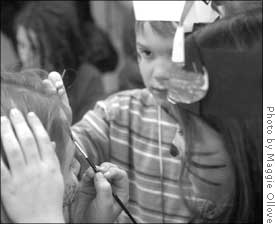
| << Front page | Arts | March 9, 2007 |
America Reads: Spending Time With Dr. Seuss
 |
||
| Cool Cats: Children engage in crafty endeavors. | ||
For a few hours last Sunday, the Oberlin Public Library ceased to be a haven for those seeking quiet and solitude. That afternoon, it was transformed into a hub of music and activity, where children with painted faces could wear paper striped hats, get balloon animals, watch performances and even shoot hoops — all in celebration of Dr. Seuss.
For eight years now, Oberlin College’s America Reads program has been holding a celebration at the library the weekend after Dr. Seuss’s birthday in order to promote reading among children. The program tries to create a fun atmosphere in the library so that youngsters can become acquainted with the facility and want to return.
As I walked into the library on this particular Sunday, I was greeted with the sound of rap music. Curious, I followed the construction paper footprints taped to the floor, and came upon the source: a dance troupe called “And What!?” was performing for an audience of elementary school students.
“And What!?” was only one of many acts that College seniors Sarah Heaton and Marty Frazier brought in for the day. Heaton and Frazier organized the entire event for their Winter Term projects, coming up with ideas for activities as well as performers.
The theme of this year’s Dr. Seuss Day was “Shape Up Your Reading with Dr. Seuss,” based on the quote, “You’re in pretty good shape for the shape you are in” from Dr. Seuss’s book You’re Only Old Once.
Volunteers ran a variety of activity stations. In keeping with the theme at the “Shape of You” station, kids stood against large pads of paper hung from the walls while volunteers traced their outlines. At another station, “Letter Shapes,” they were given cutouts of letters and asked to write or draw things that started with that letter. There was even one activity about getting in shape: kids spelled a word, and then got to shoot a ball into a small basketball hoop attached to the wall. They were rewarded with a sticker.
Other activities for the children promoted reading and writing more directly. There was a “Fishing for Story Ideas” station, where kids with magnetic fishing rods caught pieces of construction paper that said things like “once I had a magic box…” At an adjoining table, children could write their own stories in blank books. At the “Velcro Poetry” station, one third grader had pieced together: “footballs stick and dream/ they shake and shower/ and swim and crunch/ play with the brown ball.”
Amid all of the games, there was a table labeled “Family Literacy Information for Parents.” This table offered multiple pamphlets with advice on getting children to read. It also offered a parent raffle, where grown-ups could win a $25 gift certificate to Ben Franklin or an Oberlin T-shirt. This table was staffed by schoolteachers and literacy experts.
The coordinators of Dr. Seuss Day took many pains to ensure that the program would have some impact on the volume of books that children read. At the table where people filled out nametags, there was a colorful sign that urged kids to register for a library card. There were also multiple pamphlets, including “How to Help Your Child Become a Writer,” which gave such advice as, “Encourage a young child’s scribbles and letter-like symbols, knowing that these demonstrate the beginnings of writing.” Additionally, every child who came to the celebration received a free book.
I asked Andy Frantz, the director of the America Reads program and a co-organizer of this event, whether this day actually has any impact on the number of books children read. He responded that while there are no concrete statistics, he believes it must have some effect. About 200 kids come every year; when the children see the library as a fun place, Frantz hopes that they will return.
About us
Subscriptions
Advertising